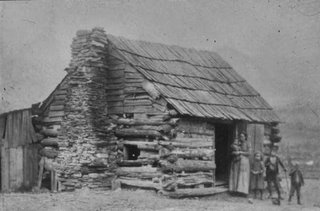Log Structures of the Appalachians - Part II - The Log House

The log house was unknown in America until the Swedish and Finnish peoples settled in Delaware and Maryland in 1638. Horizontal log houses were traditional in Scandinavia and were well suited to the new, heavily-timbered American landscape. In the early 1700's Germans and Scotch-Irish immigrants settled in Pennsylvania. Again, each group brought their traditional European construction methods with them in the form of stone cottages and log cabins. The practice of building log houses in Appalachia developed from the influence of German and Scandinavian traditions. This form of construction combined with Scotch-Irish stone masonry and English design elements to produce the typical Appalachian log house.
Logs used in house construction were usually of chestnut, oak, poplar, and spruce. A good working log was generally 12 to 15 inches in diameter and 25 to 30 feet in length. These were hewn flat on either 2 or 4 sides, or left in the round. Early cabins were usually rough, temporary structures, with non-hewn logs. Hewn logs were used when a more finished look and permanence were desired.
Logs are held in position at building corners by a system of notching. The particular style of corner-timbering used is one of the most distinctive features of log building. Notching is studied by scholars to determine the age and origins of log architecture. Saddle or round notching was sometimes used with projecting corners and round logs. This was one of the most common forms of notching in Appalachia, because it was quick and relatively easy. V-notching was characteristics of Pennsylvania German houses and it found its way south to the mountains of Appalachia. Each log was hewn with an inverted V on the edge and on the underside. These fitted tightly together, forming a strong joint.
Full dovetail notching, developed in Europe and found frequently in Pennsylvania, is rarely found in the mountains of Appalachia. A full-dovetail is cut at a compound angle on both top and bottom edges and is the most elaborate form or corner timbering. Early in the development of log construction in Appalachia, full-dovetail seemingly evolved into the half-dovetail notch which provided the same sound joint with less labor. The top edge of the logs has a simple notch angled downward from back to front, and the bottom has a simple notch angled upward from the end. This dovetail is often known simply as "dovetail" in the mountains. Square notching is believed to be English in origin and is usually found in the Eastern portions of Virginia and the Carolinas. However, a few examples of square notching are found in the mountains.
Other features of folk architecture are studied for origins and age. The Germans and Scotch-Irish excelled in the art of stone masonry. This skill was reflected in the fireplaces, chimneys, and foundations of their log structures in Northern Appalachia. Solid stone foundations are rarely seen farther south on buildings other than homes. Barns, outbuildings, and most houses in the Southern region were almost always supported by a simple series of stone piers. These are laid dry, or with mud, one on top of the other. Stone piers and foundations provided a means of leveling a building as well as helping to prevent termite infestation. Sometimes posts of locust or oak logs were used as foundation piers.
You can read Part I, "The First Settlers" here.
Tags: [Blue Ridge][Appalachia][Log Cabins]

0 Comments:
Post a Comment
<< Home